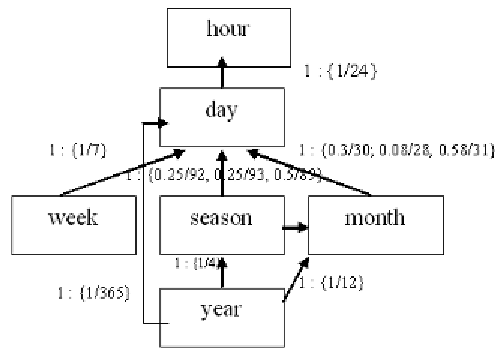Database Reference
In-Depth Information
Figure 5. Simplified example of the graph representing the relationships between time granules: on each
edge the fuzzy set defines the conversion function F of granules
functions F
i,j
associated to the edges of the path from node G
'
to node G as proposed in (De Caluwe et
al., 2000).
Nevertheless, since there can be more than a single path
P
1
,..P
k
,
connecting two nodes in the hierarchy
(e.g. in figure 5 we have two paths connecting
year
to
day
:
P
1
=
year
,
season
,
day
and
P
2
=
year, month,
day
), by applying a transformation using the distinct paths, depending on the followed path, one can
obtain multiple definitions
t
P1
,..
t
Pk
of the same temporal indication
t
.
In order to reconcile these definitions we select the shortest path connecting the two nodes. If more
paths with same length exist we generate the maximum bound of their definitions:
t
P1
∧
P2
∧
Pk
(g)= max(
t
P1
(g)..
t
Pk
(g))
The reason for this choice is that the maximum bound comprehends all possible definitions of the
temporal indication on the domain G.
When matching a temporal metadata item with a temporal query condition, we transform the one
defined on the coarser granularity domain into the finer domain so that we obtain two homogenous
temporal indications expressed with same granularity.
At this point the users' temporal query specifications and the temporal metadata are converted into
their internal fuzzy set representations μ
t
.and μ
Q,
respectively, and can be matched as described in the
following paragraph.
Partial Matching of Homogenous Imperfect Temporal Indications
In order to match the fuzzy temporal metadata, represented by μ
t
, and the soft temporal constraint, rep-
resented by μ
Q,
we rely on the fuzzy database framework by adopting the representation-based approach
proposed in (Bosc and Pivert, 2000; Bordogna and Pasi, 2007).
We are aware that temporal reasoning methods on fuzzy temporal constraints could be a more adequate
and specific framework to face this task (Vila, 1994; Vila and Godo, 1995; Deng et al., 2009), but we

